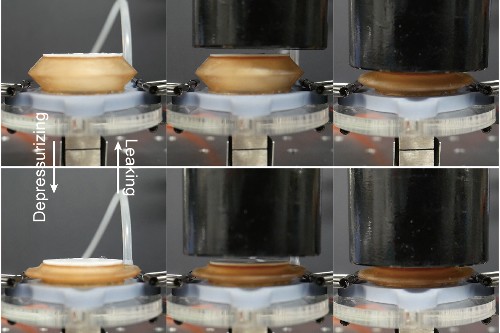| Jun 07, 2023 | |
Sponge makes robotic device a soft touch |
|
| (Nanowerk News) A simple sponge has improved how robots grasp, scientists from the University of Bristol have found. | |
| This easy-to-make sponge-jamming device can help stiff robots handle delicate items carefully by mimicking the nuanced touch, or variable stiffness, of a human. | |
| Robots can skip, jump and do somersaults, but they’re too rigid to hold an egg easily. Variable-stiffness devices are potential solutions for contact compliance on hard robots to reduce damage, or for improving the load capacity of soft robots. | |
| This study, published at the IEEE International Conference on Robotics and Automation (ICRA) 2023 ("A Silicone-sponge-based Variable-stiffness Device"), shows that variable stiffness can be achieved by a silicone sponge. | |
 |
|
| Robot sponge. (Image: Tianqi Yue) | |
| Lead author Tianqi Yue from Bristol’s Department of Engineering Mathematics explained: “Stiffness, also known as softness, is important in contact scenarios. | |
| “Robotic arms are too rigid so they cannot make such a soft human-like grasp on delicate objects, for example, an egg. | |
| “What makes humans different from robotic arms is that we have soft tissues enclosing rigid bones, which act as a natural mitigating mechanism. | |
| “In this paper, we managed to develop a soft device with variable stiffness, to be mounted on the end robotic arm for making the robot-object contact safe.” | |
| Silicone sponge is a cheap and easy-to-fabricate material. It is a porous elastomer just like the cleaning sponge used in everyday tasks. | |
| By squeezing the sponge, the sponge stiffens which is why it can be transformed into a variable-stiffness device. | |
| This device could be used in industrial robots in scenarios including gripping jellies, eggs and other fragile substances. It can also be used in service robots to make human-robot interaction safer. | |
| Mr Yue added: “We managed to use a sponge to make a cheap and nimble but effective device that can help robots achieve soft contact with objects. The great potential comes from its low cost and light weight. | |
| “We believe this silicone-sponge based variable-stiffness device will provide a novel solution in industry and healthcare, for example, tunable-stiffness requirement on robotic polishing and ultrasound imaging.” | |
| The team will now look at making the device achieve variable stiffness in multiple directions, including rotation. |
| Source: University of Bristol (Note: Content may be edited for style and length) |
We curated a list with the (what we think) 10 best robotics and AI podcasts – check them out!
Also check out our Smartworlder section with articles on smart tech, AI and more.

